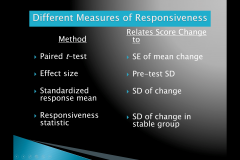![]()
![]()
![]()
Use LEFT and RIGHT arrow keys to navigate between flashcards;
Use UP and DOWN arrow keys to flip the card;
H to show hint;
A reads text to speech;
18 Cards in this Set
- Front
- Back
|
Key Properties of ClinicalMeasurements |
Key Properties of Clinical Measurements (Very Reliable & Responsible Girl)
}Validity }Reliability }Responsiveness }Generalizability |
|
|
Validity |
Validity: The degree to which the results of a measurement correspond to the true state of the phenomenon being measured. -Synonym is accuracy. |
|
|
Types of Validity |
Types of Validity (Face Contest: Criteria Construct) Face Validity: Does the measurement appear to test what it is supposed to? Content Validity: Do the items sample from the universe of content that defines the variable? Criterion Validity: Does the instrument predict a gold standard test? ◦Concurrent ◦Predictive Construct Validity: Does the measurement correlate with other measurements of the variable/contstruct? |
|
|
Bias |
Bias Aprocess at any stage of inference tending to produce results that departsystematically from the true (or valid) values (the opposite of a valid measure is a biasedmeasure). |
|
|
Reliability |
Reliability: The degree to which a measurement yields the same results in repeated applications on an unchanged population or phenomenon. Synonyms:reproducibility and precision |
|
|
Reliability For repeated measures of a singlevariable in one person |
Reliability: For repeated measures of a single variable in one person X = T + E Where: X =observed score T =true score E =random error |
|
|
Reliability: For repeated measures across persons |
Reliability:For repeated measures across persons VAR (X)= VAR (T) + VAR (E) }Reliability is estimated as R where R = VAR(T) / VAR (X) = 1 – (VAR (E)/VAR (X)) |
|
|
Why Reliability is often NOT high: The Sources of Variation in Clinical Measurement The Examiner |
TheExaminer :(BI DIP) B- Biologicvariation in the senses I- Thetendency to record inferencerather than evidence D- Ensnarementby diagnosticclassification schemes I- Simple incompetence or inexperience P- Entrapmentby priorexpectation |
|
|
Why Reliability is often NOT high: The Sources of Variation in Clinical Measurement The Examined |
TheExamined(BIT M) B- Biologicvariation in the system being examined I- Effectsof illness and medications T- Toss-ups M- Memoryand rumination |
|
|
Why Reliability is often NOT high: The Sources of Variation in Clinical Measurement The Examination |
TheExamination E - Disruptive environments for the examination I- Disruptive interactions between examiners and examined D- Incorrect function or use of diagnostictools |
|
|
Strategies for Minimizing Observer Variation |
#Strategies for Minimizing Observer Variation (CST SP) C=CLEARLY DEFINED CRITERIA S=STANDARDIZED PROCESS } T=OBSERVER TRAINING S=SINGLE OBSERVER P=PATIENT SELF ASSESSMENT |
|
|
Responsiveness |
Responsiveness: The degree to which a measure detects clinically meaningful change, particularly the change due to a treatment effect. Synonym is sensitivity to change. |
|
|
Defining Clinically MeaningfulChange |
Defining Clinically MeaningfulChange }Expert Opinion } }Patient Opinion } }Benchmark Therapy } }Statistical Estimate |
|
|
Effect Size |
Effect Size = Posttreatment – Pretreatment Mean -------------------------------------------------- Pretreatment StandardDeviation |
|
|
Different Measures ofResponsiveness |

|
|
|
Generalizability |
Generalizability The degree to which the measurementperforms in a similar fashion when applied to different populations orphenomena. }Synonym is external validity. |
|
|
Dimensions of Generalizability |
Dimensions of Generalizability }Demographics }}Diseases }}Doctors }Drugs |
|
|
Other Considerations in Choosing aMeasurement |
Other Considerations in Choosing a Measurement (ROS LI) Relevance}} Objectivity}} Standardization}} Interpretability} Logistics |

